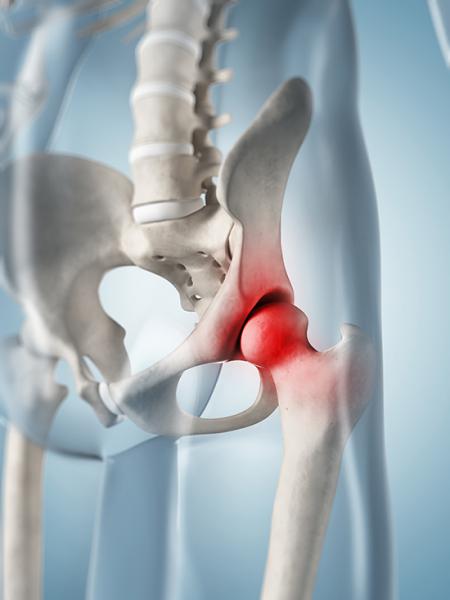Researchers discover new genetic mutation linked to osteonecrosis of the hip
MONTREAL, 13 July, 2016 – Scientists at the Research Institute of McGill University Health Centre (RI-MUHC) have discovered a new genetic mutation linked to osteonecrosis of the hip, specifically the femoral head – the spherical-shaped mass at the top of the femur. This breakthrough could allow doctors to identify and treat the disease before symptoms arise and potentially avoid hip replacements.

Osteonecrosis or “bone death” of the femoral head is a serious disease that is caused by interruption of blood flow in the hip bone. Patients experience pain as the disease progresses and the bone and surrounding joint collapse. Ultimately, in end-stage osteoarthritis, the patient becomes unable to walk and the hip joint must be replaced. “It is a severely debilitating disease that is usually linked to identifiable risk factors such as glucocorticoid treatments, blood cancers and in some rare cases, to a genetic cause,” explains Dr. Chantal Séguin, Hematologist-oncologist at the Bone Engineering and Vascular Biology Research Lab of the RI-MUHC, and senior author on the scientific paper published recently in the Journal of Medical Genetics.
Through the specialized Osteonecrosis Clinic established at the MUHC’s Montreal General Hospital, led by Dr. Séguin and orthopedic surgeon Dr. Ed Harvey, the researchers diagnosed advanced osteonecrosis in 4 out of 6 siblings in a family of European descent. Their team discovered a novel genetic mutation on a gene called TRPV4 (transient receptor potential vanilloid 4). The TRPV4 gene is known to play a critical role in blood flow control and bone cell development. Until this new discovery, only one other mutation had been identified in a few families of Asian descent and the findings have had limited potential for early diagnosis and new targeted therapy.
“The mutation was found to be common to all affected family members and absent in the unaffected family member, linking this new mutation to osteonecrosis,” says Dr. Séguin. “While it was known that pathogenic TRPV4 mutations affected the skeleton and the nervous system, this is the first time it has been associated with osteonecrosis of the femoral head.”

Dr Chantal Séguin, Hematologist-oncologist at the Bone Engineering and Vascular Biology Research Lab of the RI-MUHC .
Although the true prevalence of the disease is unknown, as many as 30,000 new patients are diagnosed each year in the United States, and the incidence is increasing. Many patients are under the age of 25 when diagnosed. The lack of knowledge surrounding osteonecrosis places a major financial burden on the Quebec and Canadian healthcare system.
"If we consider all Europeans and their distribution worldwide, it is likely that this mutation could be found in larger populations,” explains Dr. Séguin. “The identification of this novel mutation will help to reveal the biological pathways that lead to the disease, and aid in the development of new treatments that target its cause rather than its symptoms."
This novel discovery could also help to better understand the biological mechanisms in the much more common form of osteonecrosis of the femoral head, namely osteonecrosis induced by the use of glucocorticoids, or more commonly, steroids. Glucocorticoids are a family of medications used worldwide as either an anti-inflammatory agent, or as an important drug in many chemotherapy regimens used to treat patients with blood cancer. It is also well known that people who are using steroid medication for various illnesses are also at risk and it is estimated that greater than 60 million people are presently taking this medication worldwide.
-30-
Funding
This research was funded by Fonds de Recherche Québec - Santé (FRQ-S), Montreal General Hospital Foundation, Yvon Boulanger Foundation, Canadian Institutes of Health Research, National Institutes of Health, Fondation Leducq and Totman Medical Research Trust.
1 Department of Medicine, Division of Hematology and Oncology, McGill University Health Centre, Montreal, Quebec, Canada, 2 Department of Pharmacology, University of Vermont, Burlington, Vermont, USA,3 Department of Molecular Physiology and Biological Physics, University of Virginia, Charlottesville, Virginia, USA, 4 Robert M. Berne Cardiovascular Research Center, University of Virginia, Charlottesville, Virginia, USA, 5 Department of Human Genetics, McGill University, Montreal, Quebec, Canada, 6 McGill University and Genome Québec Innovation Centre, Montreal, Quebec, Canada, 7 Department of Surgery, Division of Orthopedic Surgery, McGill University Health Centre, Montreal, Quebec, Canada, 8Department of Neurology & Neurosurgery, McGill University, Montreal, Quebec, Canada,9 Institute of Cardiovascular Sciences, University of Manchester, Manchester, UK.
The Research Institute of the McGill University Health Centre (RI-MUHC) is a world-renowned biomedical and healthcare research centre. The Institute, which is affiliated with the Faculty of Medicine of McGill University, is the research arm of the McGill University Health Centre (MUHC) – an academic health centre located in Montreal, Canada, that has a mandate to focus on complex care within its community. The RI-MUHC supports over 460 researchers and close to 1,300 research trainees devoted to a broad spectrum of fundamental, clinical and health outcomes research at the Glen and the Montreal General Hospital sites of the MUHC. Its research facilities offer a dynamic multidisciplinary environment that fosters collaboration and leverages discovery aimed at improving the health of individual patients across their lifespan. The RI-MUHC is supported in part by the Fonds de recherche du Québec – Santé (FRQS). rimuhc.ca
Contact
Valérie Harvey
Communications Coordinator – ResearchPublic Affairs & Strategic planning
McGill University Health Centre 514 934-1934 ext. 71381
